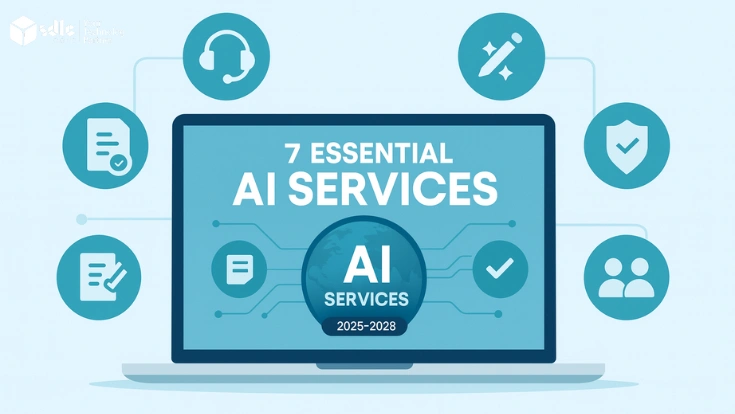Introduction
Agriculture is evolving faster than ever. Farmers now deal with unpredictable weather, rising costs, and the demand for sustainable food. Traditional methods can’t keep up, but Artificial Intelligence (AI) is bridging the gap. With tools like drones, IoT sensors, and machine learning, AI supports smarter farming through disease detection, smart irrigation, weed control, robotic harvesting, and supply chain traceability.
To bring these innovations to life, many farms collaborate with an AI development company. These experts design models, connect IoT devices, and build automation systems adapted to local conditions. In this article, we share a technical roadmap for AI in agriculture covering data, models, KPIs, and future trends.
Why AI Outperforms Traditional Farming
Conventional farming follows fixed routines: fertilize on dates, irrigate weekly, spray on schedules. This wastes resources and ignores field variability.
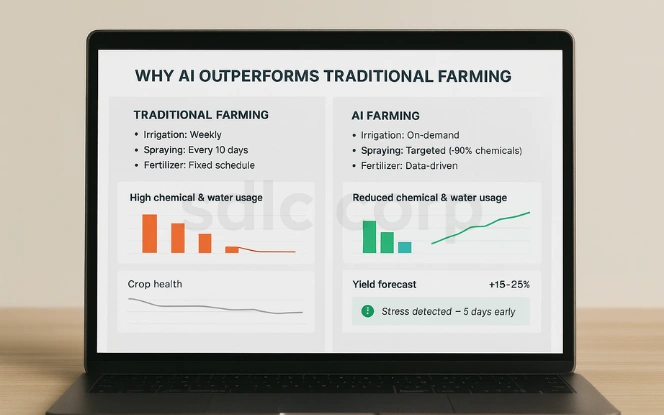
AI makes farming adaptive:
- AI sprayers detect weeds and cut chemical use by up to 90%.
- Stress detection models find issues days earlier than human scouts.
- Yield forecasts become 15–25% more accurate.
Core Data Streams in AI Agriculture
Satellite and Drone Imaging
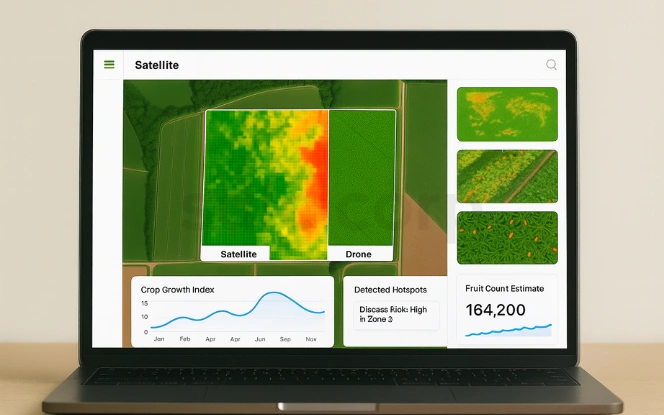
Satellites like Sentinel-2 provide wide, frequent coverage of large areas, while drones capture highly detailed images of fields. Satellites are used to monitor seasonal crop growth, while drones help detect disease hotspots and perform fruit counts.
IoT Sensors (Soil and Weather)
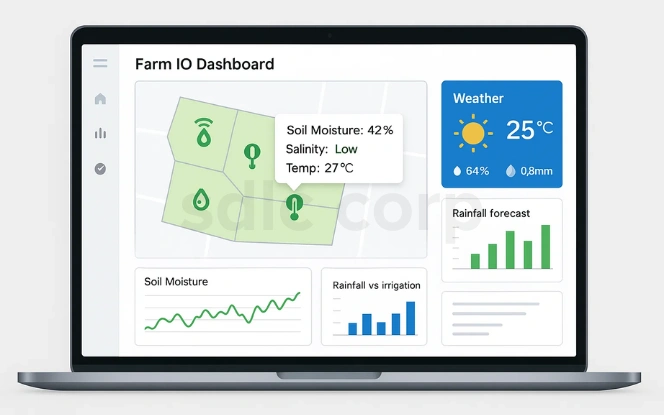
IoT sensors measure soil moisture, salinity, and real-time microclimate variations. These inputs guide irrigation models and improve water management. Many farms integrate these systems with the help of IoT developers.
Equipment Telemetry (ISOBUS)
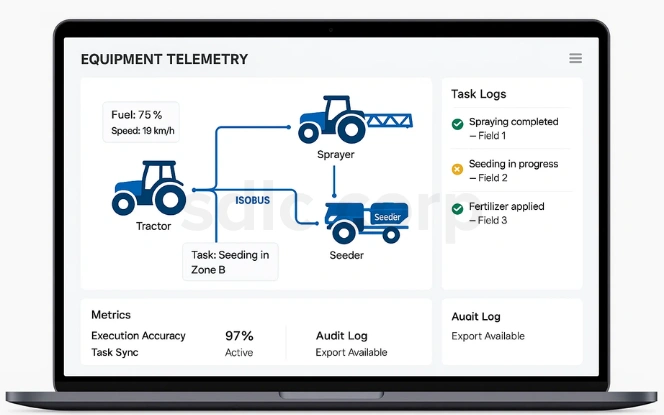
Modern implements communicate through the ISOBUS standard (ISO 11783), which allows seamless data sharing between machines. Equipment executes variable-rate prescription maps, while task controllers log compliance data for audits.
Ground-Level Scouting

Mobile applications and drones capture images of weeds, pests, and nutrient deficiencies directly in the field. These ground-level datasets enhance the accuracy of custom AI solutions by validating satellite and sensor insights.
AI Models in Agriculture
Vision Models

- Object Detection (YOLO): A model that detects weeds, pests, or fruits in real time during spraying or harvesting.
- Segmentation (U-Net): A deep learning model that marks diseased leaves or crop rows pixel by pixel for accurate mapping.
- Transformers: Advanced models that improve image classification in complex farm conditions like low light or dense crops.
Time-Series Forecasting
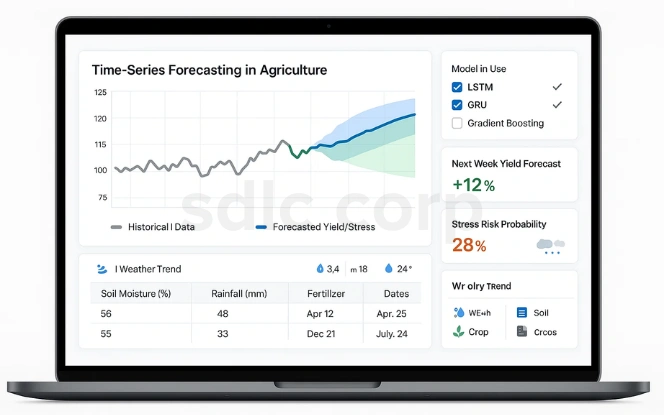
- LSTM & GRU: Neural networks that predict yield and stress by analyzing historical vegetation and weather data.
- Gradient Boosting: An algorithm that handles structured datasets such as soil and rainfall records for reliable forecasting.
Prescriptive AI
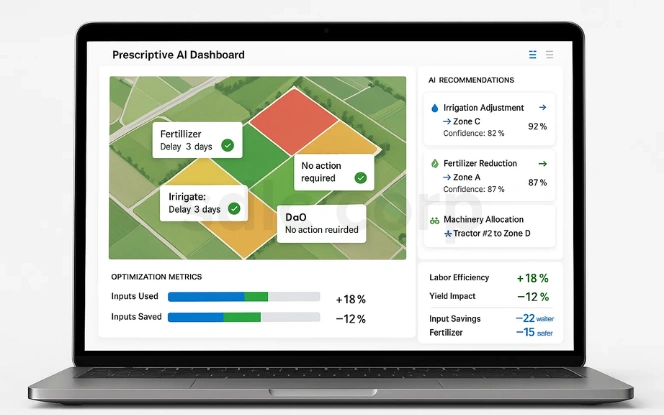
- Reinforcement Learning: A method that suggests optimized irrigation and fertilization schedules by learning from field conditions.
- Optimization Models: Mathematical models that allocate labor, machinery, and inputs efficiently across farm operations.
Geospatial Analytics
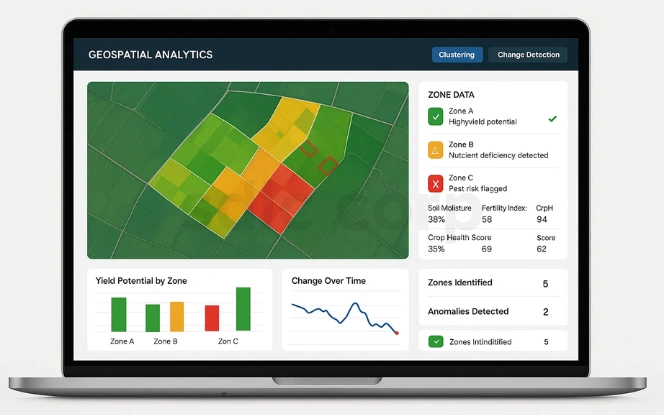
- Clustering: A technique that divides farms into performance zones to guide variable-rate seeding and fertilization.
- Change Detection: An approach that flags early signs of pest infestation or nutrient stress using imagery analysis.
Irrigation Optimization with AI
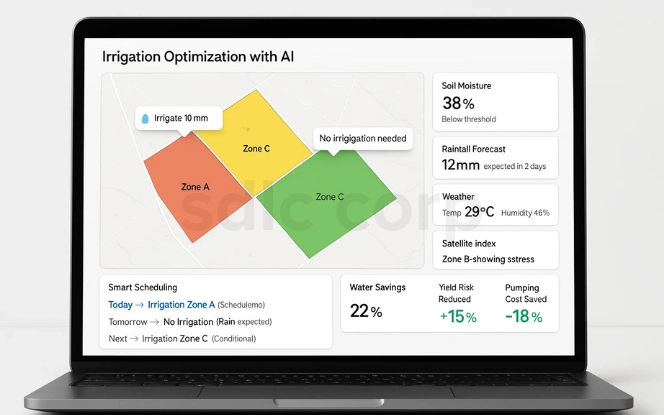
Water is the scarcest and most valuable input in farming. AI helps manage it more efficiently by turning multiple data streams into actionable irrigation plans.
- Data Integration: AI combines soil probe readings, local weather data, rainfall forecasts, and satellite imagery to assess the real-time water needs of crops.
- Smart Scheduling: Instead of following rigid weekly watering routines, AI dynamically schedules irrigation only when the soil and plant conditions require it.
- Precision Delivery: By aligning water delivery with crop demand, AI ensures that plants receive the right amount at the right growth stage.
- Yield Protection: Optimized watering prevents under-irrigation stress and overwatering damage, supporting healthy crop development.
- Resource Conservation: Efficient water use reduces waste, lowers pumping costs, and conserves groundwater reserves for long-term sustainability.
Weed, Pest, and Disease Management

Weed Control
AI sprayers with cameras apply herbicide only where weeds exist. This cuts costs and reduces chemical residues.
Disease Detection
AI models trained on leaf datasets detect fungal or bacterial infections early, allowing farmers to act before losses escalate.
Pest Monitoring
Smart traps and drones detect insect activity. Integrated with AI, these systems predict outbreaks, enabling preventive treatment.
Robotics and Automation
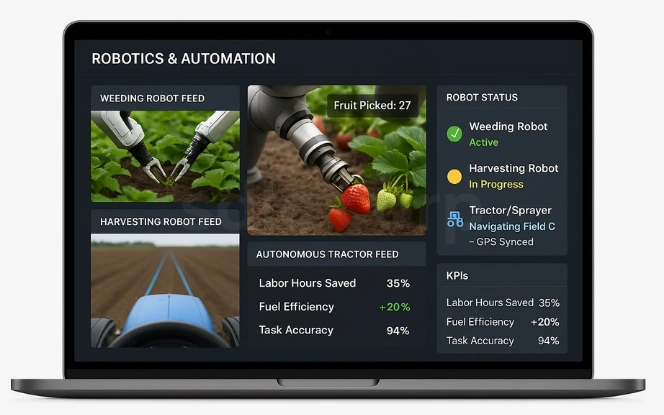
AI-driven robots are now common in high-value farming:
- Weeding robots: Mechanically remove weeds without chemicals.
- Harvesting robots: Use vision-guided arms for crops like strawberries.
- Autonomous tractors and sprayers: Operate independently using GPS and AI navigation.
AI Technology Stack in Agriculture
Field Layer
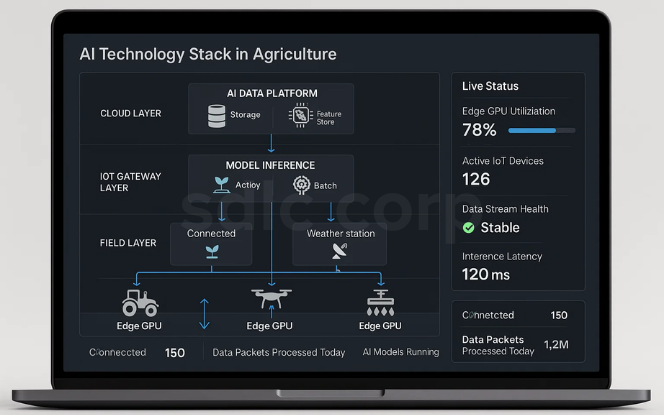
- Edge GPUs on machines: Enable real-time model inference directly on tractors, drones, and sprayers without relying on cloud connectivity.
- IoT gateways: Connect soil sensors, weather stations, and crop monitors, ensuring continuous data collection from the field.
Data Platform
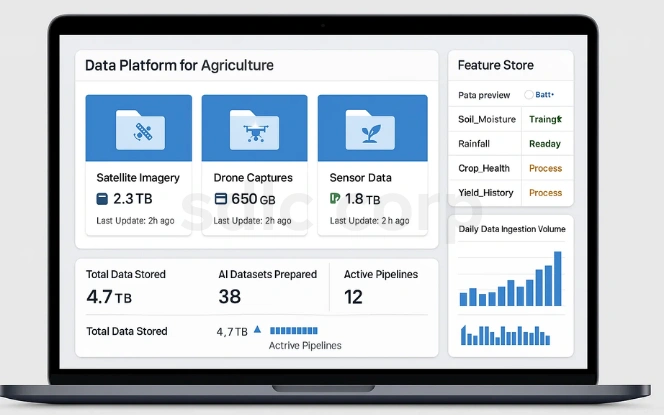
- Cloud storage: Stores large volumes of satellite imagery, drone captures, and time-series sensor data in one centralized system.
- Feature stores: Prepare structured, training-ready datasets so AI models can be trained consistently and efficiently.
Model Serving
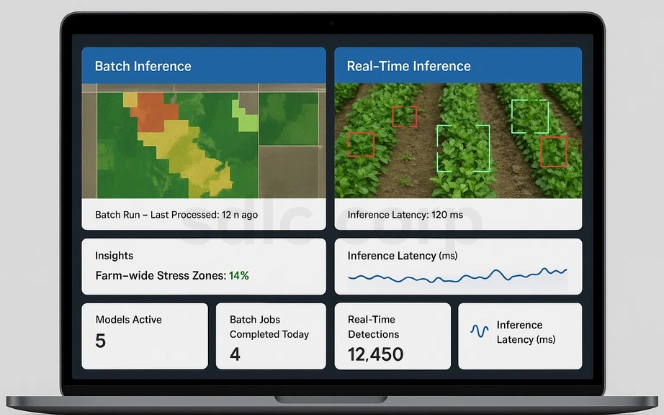
- Batch inference: Processes large datasets like satellite imagery to deliver periodic insights across entire farms.
- Real-time inference: Supports on-the-fly decisions for sprayers, robots, and scouting apps where immediate responses are critical.
Farm Management System (FMIS)

- Prescription maps: Creates variable-rate seeding, fertilization, and irrigation plans tailored to specific zones.
- ISOBUS integration: Syncs seamlessly with farm equipment, ensuring compatibility across different brands and machines.
- Performance tracking: Monitors compliance, measures ROI, and provides dashboards for data-driven decision-making.
KPIs for AI in Agriculture
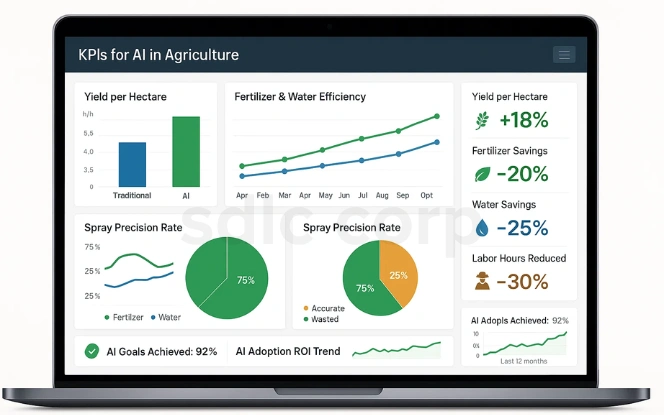
To measure the true impact of AI adoption, farmers should track these key performance indicators:
- Yield per hectare: Measures productivity improvements, showing how AI-driven decisions increase output compared to traditional practices.
- Fertilizer and water efficiency: Tracks how effectively inputs are used, reducing waste and costs while maintaining or improving yields.
- Spray precision rate: Evaluates the accuracy of AI-guided sprayers, ensuring pesticides and herbicides hit only the intended targets.
- Labor savings from automation: Reflects reductions in manual hours spent on scouting, spraying, and harvesting, highlighting efficiency gains.
- ROI from AI interventions: Demonstrates the financial return on investment by combining input savings with yield improvements.
Future Trends in AI Agriculture

1. Multimodal AI Models
Combining satellite imagery, IoT data, and market trends for holistic insights.
2. Federated Learning
Models train across multiple farms without exposing raw data, ensuring privacy.
3. Digital Twins
Virtual farm replicas will let farmers test strategies digitally before applying them.
4. Fully Autonomous Systems
Tractors, drones, and sprayers will coordinate tasks independently.
5. Blockchain for Traceability
AI-linked blockchain will secure transparent food supply chains. Farms can use blockchain development for compliance.
Advisory, Governance, and AI System Design
AI systems in agriculture must address data quality, model transparency, and environmental variability. Advisory support helps define appropriate levels of automation and ensures outputs remain interpretable for farmers and cooperatives. An AI consulting company is often involved in establishing governance frameworks and long-term planning for agricultural AI platforms
Enterprise-Scale Agricultural AI Platforms
Large agribusinesses operate across multiple farms, regions, and supply chains. Enterprise-grade AI platforms support centralized analytics while allowing local customization. Architectural approaches commonly used by an enterprise AI development company are often applied when designing scalable agricultural intelligence systems.
Conclusion
AI is already reshaping agriculture, supporting irrigation optimization, robotic harvesting, and crop protection to improve productivity, reduce costs, and ensure sustainability. Forward-looking farms are scaling these systems by partnering with specialists, often choosing to hire AI developers who can build models, integrate IoT data, and design dashboards that deliver measurable ROI, helping agriculture progress toward a profitable, transparent, and resilient future.
Related Blogs You Should Explore:
FAQ's
How Is Ai Different From Precision Farming?
Precision farming relies on GPS and sensors. AI adds predictive analytics and automation.
Can Small Farms Adopt Ai?
Yes. Mobile apps and cloud AI tools make it affordable for smallholders.
What Are The Top Ai Applications Today?
Smart irrigation, weed detection sprayers, and disease monitoring.
Will Ai Replace Agronomists?
No. AI provides decision support; agronomists remain essential.
What Roi Can Farmers Expect?
Typically, 10–30% savings in inputs and 15–25% gains in yield stability.




